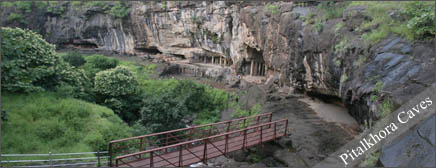| Caves of
the same period as Ajanta |
 |
|
| Not as well known as Ajanta
yet also interest are the rock-cut caves of Pitalkhora
in the Satamala range of the Sahyadri hills. There are
thirteen caves, set high up on the hill, overlooking picturesque
ravines. Many of the caves contain carvings and paintings
that date from the 1st century B.C. to the 5the century
A.D. They were discovered after Ajanta and are first mentioned
in a publication of 1853 where Caves 3 and 4 are described. |
| Many of the carvings as well
as the paintings have been damaged by the weather and
vandals. The caves appear to be of the early Hinayana
period of Buddhism and are contemporary to the other rock-cut
Buddhist temples in western India. They were probably
excavated and carved during the Satavahana-Kshaharata
regimes. There appears to be a subsequent period of desertion
and re-occupation much later in the 5th century A.D. during
the Vakataka rule. In the Hinayana Buddhist period no
images of Buddha or Bodhisattvas (celestial beings personifying
the virtues of Buddha and attending to the needs of the
people) appear in places of worship and none can be seen
in the caves of Pitalkhora except for the paintings in
Cave 3, which belong to the later phase of occupation. |
| Because of their
locations the caves have been divided into two groups.
Caves 1-9 face north and east and are adjacent to each
other. These are in Group I. On the other side of the
hill, facing southwards are Caves 10-14 which make up
Group II. |
| Many of the caves have crumbled
and are badly damaged. Cave 1 looks like a huge natural
opening. There are indications of cells and door supports
and it may have formed an extensive Vihara or monastery. |
| Caves 2, 3 and 4 share the same forecourt and are presumed
to be of the same period. The dividing wall between 2
and 3 has disappeared, 2 was a Vihara and has an interesting
rock-cut drain which prevents water from flowing into
Cave 3 which was a prayer hall. |
| The best paintings are in Cave 3. These appear on the
pillars and side walls. 37 pillars used to separate the
aisle from the hall and these were donated individually
as inscriptions on the 10th and 11th pillars, on the right,
indicate. The donors of both these pillars were residents
of Paithan. Steps lead down to a basement containing several
carvings. Rare crystals and other reliquaries were found
in the stupa here. |
|